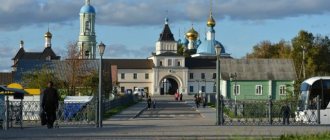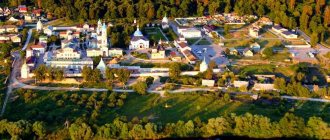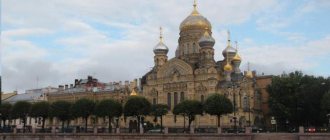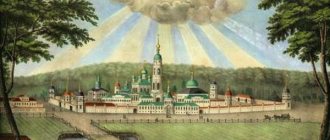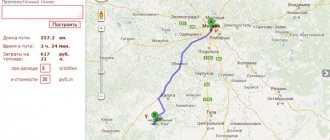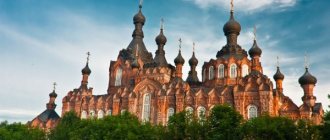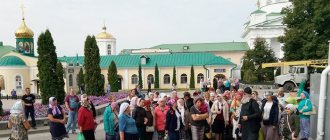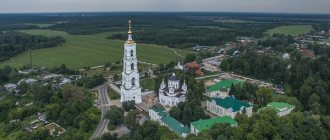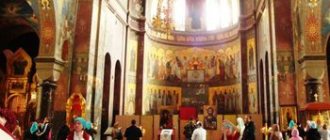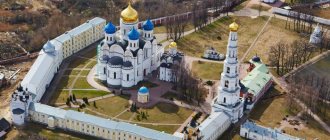OPTINA PUSTIN
OPTINA PUSTIN, an Orthodox stauropegial (since 1987) male monastery in honor of the Entry into the Temple of the Blessed Virgin Mary, located approximately 3 km from the city of Kozelsk (Kaluga region), near the river. Zhizdra.
Optina Pustyn. General form. Photo by A. I. Nagaev
The name, according to legend, goes back to the legendary repentant robber Opta, who allegedly founded the O. p. It is more likely that the name is connected with the period of joint (“wholesale”) residence in the monastery of monks and nuns. Perhaps the foundation of O. p. dates back to the 15th century. It was first mentioned in the scribe books of Kozelsky. for 1629–31 (the text contains an indication of the existence of O. p. in the late 16th century). During the Time of Troubles, the O.P. was most likely ruined, but was soon restored. The monastery's investors were Tsarevna Sofya Alekseevna, Tsar Ivan V Alekseevich, his wife Tsarina Praskovya Feodorovna, Tsar (from 1721 Emperor) Peter I, and others. In 1724, the O.P. was abolished and assigned to the Belyov Spaso-Preobrazhensky Monastery, but already in 1726, at the request of benefactors, it was restored. In 1764 it was designated as a provincial monastery; the brotherhood consisted of several monks. The gradual revival of O. p. began with the end. 18th century, which was facilitated by the activities of Metropolitan. Moscow Platon (Levshin). In 1821, under the patronage of bishop. Kaluga (later Metropolitan of Kyiv) Philaret (Amphiteatrov) near the O. p. for a solitary monastic life, the St. John the Baptist monastery was founded, in which those invited to the monastery of Bishop began to asceticize. Filaret the ascetics brothers Moses (Putilov) and Anthony (Putilov) and several others. monks In 1824, a strict communal charter was adopted in the community center based on the charter of the Konevsky Nativity of the Mother of God Monastery.
Icon "The Council of the Reverend Elders of Optina". Late 20th century Workshop of Optina Pustyn. Church in honor of the Vladimir Icon of the Mother of God of Optina Hermitage.
During the period of the abbotship of Schema-Archimandrites Moses (Putilov) (1826–62, actually from 1825) and Isaac (Antimonov) (1862–94), the O.P. gained wide popularity thanks to its eldership. The tradition of Optina eldership goes back to the disciples of St. Paisiy Velichkovsky and originates from the settlement in 1829 of Hieroschemamonk Lev (Nagolkin) in O. The elders lived in the monastery of St. John the Baptist. Here it was possible to ensure the continuity and continuity of the eldership: after the death of the elder, the elder brethren chose his successor, sometimes serving several times. elders at the same time. The most revered Optina elders were hieroschemamonks Lev (Nagolkin), Macarius (Ivanov), Ambrose (Grenkov; see Ambrose of Optina), Hilarion (Ponomarev), Anatoly (Zertsalov), Joseph (Litovkin), schema-archimandrite Varsonofy (Plikhankov), hieroschemamonks Anatoly ( Potapov), Nektary (Tikhonov) and Hieromonk Nikon (Belyaev). The elders received and cared for not only the brethren, but also all willing pilgrims, and corresponded with them.
Among the many visitors to the elders - bishops [Metro. Ioannikiy (Rudnev), bishop. Nikon (Rozhdestvensky), St. Macarius (Nevsky), plural. Kaluga bishops, etc.], members of the imp. families (Grand Prince Konstantin Konstantinovich with children, Grand Prince Primts. Elizaveta Fedorovna), scientists, philosophers, writers, poets (N.V. Gogol, brothers I.V. Kireevsky and P.V. Kireevsky, K. S. Aksakov and I. S. Aksakov, S. P. Shevyrev, M. A. Maksimovich, A. N. Muravyov, F. M. Dostoevsky, K. N. Leontyev, V. S. Solovyov, L. N. Tolstoy, S. A. Nilus, S. N. Durylin, etc.).
Since the 1840s On the initiative of Elder Macarius (Ivanov), the most educated monks of the O. p., including Leonid (Kavelin) and Juvenaly (Polovtsev), carried out educational activities. Thanks to the organizational efforts of Father Macarius (Ivanov), I.V. Kireevsky and others, the patronage of a number of hierarchs, primarily Metropolitan. Moscow St. Philaret (Drozdova), O. p. received the opportunity to conduct publishing activities: translations of the works of the Venerable Barsanuphius the Great and John the Prophet, Abba Dorotheos of Gaza, the Venerable Mark the Ascetic, John Climacus, Simeon the New Theologian, Theodore the Studite, Maximus the Confessor, Isaac the Syrian, John of Damascus, works of St. Nil Sorsky and others, biographies and correspondence of the Optina elders. Valuable manuscripts were kept in the libraries of the O. p. and the monastery, the oldest of which is Slav. manuscript “Words of the Fasting” by St. Isaac the Syrian, copied in 1389 in the Great Lavra on Mount Athos. A chronicle was kept at the St. John the Baptist Skete, covering the time from 1820 to 1918 (with the exception of 1861–1864 and 1883–99), which recorded the composition and movements of the brethren, tonsures, ordination, the death of monastics, the arrival of famous people, large donations, monastic construction, the publication of books prepared by monks, as well as particularly important events in the church and political sphere. life of Russia, wonderful events, etc.
"View of the monastery of St. John the Baptist." Lithography. 1881.
At 19 – beginning. 20th centuries the number of inhabitants of the O. p. grew rapidly; by 1915, 355 monastics lived there. Mn. monks of the O. p. were appointed to high positions in other monasteries and spiritual missions; Ignatius (Brianchaninov), Yuvenaly (Polovtsev), Trifon (Turkestanov), Mikhei (Alekseev) became bishops. From 2nd quarter 19th century The financial position of the O.P. was strengthened, large-scale construction was carried out, and several were opened. factories and workshops, a water supply system was installed, and the Optina breed of cows was bred. The brethren were actively involved in charity work: a school was opened at the O.P., an orphanage, an orphanage, and an almshouse were established. During the Russian tour. wars of 1877–78, Russian-Japanese. During the war of 1904–05 and the 1st World War, the monastery hospital admitted the wounded, the monastery allocated places for refugees, and made donations for the needs of the army.
In 1918, the monastic community was officially closed; the monastic community continued to exist as an agricultural community. artel With the liquidation of the artel in 1923, the remaining monastics were evicted, many of them were subsequently sent into exile or shot. In 1919–28, the Optina Pustyn Museum operated on the territory of the O. p. and the monastery. After the closure of the museum, the Optina archive ended up in the State. USSR Library named after. V.I. Lenin (now makes up funds 213 and 214 of the Department of Manuscripts of the Russian State Library). Over the years, on the territory of the O.P. there was a rest house (since 1931), an NKVD camp (1939–41), and an evacuation center. hospital (1941–43), orphanage (since 1949), professional-technical. school (since 1959). Archit. The O.P. ensemble suffered great losses. In 1974, O.P. became one of the objects protected by the state, and slow restoration of the buildings began.
O. item was returned to the Russian Orthodox Church on November 17, 1987; The monastery was restored and acquired the status of stauropegial. 1.2.1990 transferred to the monastery b. part of the monastery (the other part belonged to the literary department of the Kozelsky Museum in 1967–2005). The following were transferred as farmsteads to the O.: in 1991 in St. Petersburg, the Assumption Church. on the Lieutenant Schmidt embankment (1895–1900, architect V. A. Kosyakov), in 1997 in Moscow. Apostles Peter and Paul in Yasenevo (1751, the refectory and bell tower were added in the 1860s). On the Easter night of April 18, 1993, the murder of Hieromonk Vasily (Roslyakov) and the monks Trofim (Tatarnikov) and Ferapont (Pushkarev) took place in O.P., which caused a large public outcry. resonance.
Elder Ambrose of Optina was canonized by the local council of the Russian Orthodox Church in 1988. In 1996, the canonization of other elders as locally revered saints took place, as well as Schema-Archimandrite Moses (Putilov), Schema-Abbot Anthony (Putilov), Schema-Archimandrite Isaac (Antimonov) and Archimandrite. Isaac (Bobrakov) as part of the Council of Reverend Fathers and Elders, who shone in the Optina Hermitage. The Council of Bishops of the Russian Orthodox Church 2000 established their church-wide veneration.
The earliest of the surviving monuments of the O. p. is the Vvedensky Cathedral, built in the traditions of classicism (1750–71; partially destroyed during the years of Soviet power, restored and consecrated in 1988). Above its middle cross rises a cube topped with 5 chapters. In the 19th century the temple was expanded, the south was added. and sowing aisles (1837) and a porch with a west. entrance with paired columns raised on high pedestals. Modern architect The artistic ensemble took shape in general terms in the 19th century. In 1802–04, a 4-tier high bell tower was erected. OK. 64 m in the classicist style, completed with an attic tier with a clock and a high spire (the top was destroyed during the Great Patriotic War, restored in 1999). In 1805–11, to the south of the Vvedensky Cathedral, a cathedral was built in honor of the Kazan Icon of the Mother of God in the Empire style (partially destroyed during the years of Soviet power, restored and consecrated in 1996), crowned with a dome with a small dome without a light drum. In 1809–11, a hospital church was built in honor of the Vladimir Icon of the Mother of God (completely destroyed in the mid-20th century, restored by 1998). In 1858, the St. Venerable Church, located north of the Vvedensky Cathedral, was consecrated. Mary of Egypt and Righteous Anna, which appeared as a result of the reconstruction of the old refectory (1822–24) and was made in the style of classicism; An octagon with one head was erected on the cross-shaped building. With the advent of the new church, the monastery churches, together with the bell tower, formed a cross on the plan with the Vvedensky Cathedral in the center. In 1832–39, the territory of the O. p. was surrounded by a stone fence (partially destroyed during the years of Soviet power) with 7 towers and 2 entrance gates. The Holy Gates were located in the west. a tower with a tent topped with a figurine of a trumpeting angel.
A department was created in the St. John the Baptist Skete. architect an ensemble characterized by simplicity and modesty; most of the buildings were wooden. In the center of the site in 1821–22, Ch. monastery church dedicated to the Cathedral of St. John the Baptist - tree. a church in the Empire style, consisting of several log buildings: a vestibule, a refectory and a cube. a temple with a 7-sided apse; On the sides there are 4-column porticoes with pediments. In 1857, stone Holy Gates appeared in the monastery (on the 2nd tier there is a belfry). Stone church in the name of St. Leo ep. Katansky, etc. John of Rylsky was erected in 1901–02 in the Russian style. At the gate of the monastery there was a spring in the name of St. Ambrose of Milan with a well.
A number of buildings are located behind the fence of the O. p. In the new cemetery in 1864, a small single-domed cubic center was built. in the name of All Saints (completely destroyed in the 20th century, rebuilt in 2008). At the south gate, in 1874 a 2-story hospital building with a single-domed building was built. St. Hilarion the Great in Russian style. On the river Zhizdra was the source of St. Paphnutius Borovsky with a chapel and a bathhouse.
After the resumption of the monastery at the end. 20th century new churches were built: in 1997–2000 - in honor of the icon of the Mother of God “Spreader of the Loaves” on the territory of the monastery subsidiary farm, in 2005–07 - Transfiguration Church. near the Holy Gates of the monastery; in 2008 in the southeast. In part of the monastery, a chapel was erected over the graves of the monks killed in 1993.
Desert tourist
Photo: Optina Pustyn Monastery.
Just like many other places of pilgrimage in Rus', Optina Pustyn, where the city of Kozelsk and some villages are located nearby, provides both bread and the opportunity for economic prosperity for the surrounding areas. For example, land in a neighboring village costs no less than land in the most elite villages of the Moscow region, although this territory is not remarkable for anything other than the desert. Residents have the opportunity to accommodate pilgrims almost throughout the year.
The flow of people moves here throughout the year and practically never stops; there are always a lot of people on the territory of the monastery. Moreover, all sorts of people come here, from simple hippies who want to see some semblance of yogis only of the Russian type, to ordinary people who want to get closer to the depth of the Orthodox faith.
Geographical location and place on the map
Optina Pustyn has the following GPRS coordinates: 54.053416, 35.831969.
Located in the Kaluga region. Pilgrimage trips from Moscow to the Holy Places of Russia. More details can be found in pilgrimage.
The distance from the regional center is 79 kilometers, from the capital of Russia - 256 kilometers, from St. Petersburg - 935 km. And the shortest distance from the nearest town called Kozelsk is only 2000 meters.
We are sure that you will be interested in the article about the Nikolo-Yamsky Church in Ryazan.
Monastery after the revolution and the USSR
After the October Revolution, the spiritual center of Russia was closed in 1918.
There was an agricultural artel, a museum, a sawmill, a tannery, where monks and elders worked and also secretly continued religious activities. Pilgrims continued to go to the monastery. The succession of various organizations on the territory of the monastery was replaced by the Rest House. In 1939, a concentration camp was established here . It accommodated more than five thousand Poles who were shot at Katyn.
With the beginning of the Second World War, a hospital for the wounded was needed, and the Optina Monastery was chosen as the site. Already three years after the start of the war, the hospital was converted into an NKVD camp, intended for captured Soviet officers returning from Germany to their homeland. In 1949, the camp was replaced by a military unit.
1987 is the year of the return of Optina Pustyn to the Russian Orthodox Church. The very first liturgy was celebrated in June 1988 in the gate tower. Many years of work lay ahead to restore the holy monastery.
Monastery in the spiritual life of Russia
The enormous significance in the life of Russia can be assessed by the example of the influence of a visit to the monastery on the worldview and work of three great writers - N.V. Gogol, L.N. Tolstoy and F.M. Dostoevsky:
- N.V. Gogol visited the monastery three times. The timing of the first visit coincided with a deep spiritual crisis, aggravated by illness. A writer who has already written his best works is tormented by doubts about the correctness of his chosen field. Gogol felt the calling of a monk, dreamed of living in Optina Pustina, praying for the sins of people. The writer's gift of genius contradicted his religious beliefs. This was his tragedy. But the elders, many of whom were very educated people, and, of course, read his works, did everything possible so that the literary world did not lose the writer. Long conversations with Fr. Makariy, Fr. Porfiry and the monks of the monastery had a beneficial influence on Nikolai Vasilyevich. Father Porfiry subsequently conducted a long correspondence with the writer, was his friend and mentor;
- Leo Tolstoy visited the monastery several times. One day he and his companions came here on foot. The great writer's relationship with the church was complex. Even repeated conversations with Elder Ambrose did not return him to the fold of Orthodoxy. But here’s the strange thing: while disagreeing with the elders on religious issues, the writer considered visiting the monastery a very important event in his life;
- In 1878, the great Fyodor Mikhailovich Dostoevsky lived here for some time. The writer’s youngest son, Alyosha, dearly beloved by his father, died of epilepsy. In the monastery the writer met and talked with Fr. Ambrose, who became the prototype of Elder Zosima in the writer’s last novel, The Brothers Karamazov.

